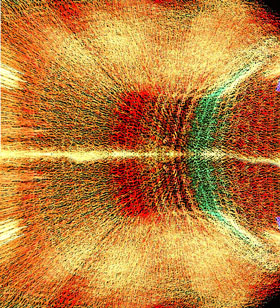Astronomers cannot see all the way back in time to the origin of the universe, but by drawing on lots of clues and theory, they can imagine how everything began.
Their model starts with the entire universe as a very hot dot, much smaller than the diameter of an atom. The dot began to expand faster than the speed of light, an expansion called the Big Bang. Cosmologists are still arguing about the exact mechanism that may have set this event in motion. From there on out, however, they are in remarkable agreement about what happened. As the baby universe expanded, it cooled the various forms of matter and antimatter it contained, such as quarks and leptons, along with their antimatter twins, antiquarks and antileptons. These particles promptly smashed into and annihilated one another, leaving behind a small residue of matter and a lot of energy. The universe continued to cool down until the few quarks that survived could latch together into protons and neutrons, which in turn formed the nuclei of hydrogen, helium, deuterium, and lithium. For 300,000 years, this soup stayed too hot for electrons to bind to the nuclei and form complete atoms. But once temperatures dropped enough, the same hydrogen, helium, deuterium, and lithium atoms that are around today formed, ready to start a long journey into becoming dust, planets, stars, galaxies, and lawyers.
Gravity—the weakest of the forces but the only one that acts cumulatively across long distances—gradually took control, gathering gas and dust into massive globs that collapsed in on themselves until fusion reactions were ignited and the first stars were born. At much larger scales, gravity pulled together huge regions of denser-than-average gas. These evolved into clusters of galaxies, each one brimming with billions of stars.
Over the eons fusion reactions inside stars transformed hydrogen and helium into other atomic nuclei, including carbon, the basis for all life on Earth.
The most massive stars sometimes exploded in energetic supernovas that produced even heavier elements, up to and including iron. Where the heaviest elements, such as uranium and lead, came from still remains something of a mystery.
Read More...
Their model starts with the entire universe as a very hot dot, much smaller than the diameter of an atom. The dot began to expand faster than the speed of light, an expansion called the Big Bang. Cosmologists are still arguing about the exact mechanism that may have set this event in motion. From there on out, however, they are in remarkable agreement about what happened. As the baby universe expanded, it cooled the various forms of matter and antimatter it contained, such as quarks and leptons, along with their antimatter twins, antiquarks and antileptons. These particles promptly smashed into and annihilated one another, leaving behind a small residue of matter and a lot of energy. The universe continued to cool down until the few quarks that survived could latch together into protons and neutrons, which in turn formed the nuclei of hydrogen, helium, deuterium, and lithium. For 300,000 years, this soup stayed too hot for electrons to bind to the nuclei and form complete atoms. But once temperatures dropped enough, the same hydrogen, helium, deuterium, and lithium atoms that are around today formed, ready to start a long journey into becoming dust, planets, stars, galaxies, and lawyers.
Gravity—the weakest of the forces but the only one that acts cumulatively across long distances—gradually took control, gathering gas and dust into massive globs that collapsed in on themselves until fusion reactions were ignited and the first stars were born. At much larger scales, gravity pulled together huge regions of denser-than-average gas. These evolved into clusters of galaxies, each one brimming with billions of stars.
Over the eons fusion reactions inside stars transformed hydrogen and helium into other atomic nuclei, including carbon, the basis for all life on Earth.
The most massive stars sometimes exploded in energetic supernovas that produced even heavier elements, up to and including iron. Where the heaviest elements, such as uranium and lead, came from still remains something of a mystery.












